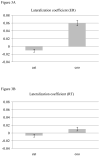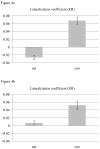Individual differences in spatial relation processing: effects of strategy, ability, and gender
- PMID: 21353361
- PMCID: PMC3081998
- DOI: 10.1016/j.bandc.2011.01.008
Individual differences in spatial relation processing: effects of strategy, ability, and gender
Erratum in
-
Corrigendum to "Individual differences in spatial relation processing: Effects of strategy, ability, and gender" [Brain Cogn. (2011) 76, 184-190].Brain Cogn. 2016 Nov;109:40-42. doi: 10.1016/j.bandc.2016.08.006. Epub 2016 Sep 16. Brain Cogn. 2016. PMID: 27643949 No abstract available.
Abstract
Numerous studies have focused on the distinction between categorical and coordinate spatial relations. Categorical relations are propositional and abstract, and often related to a left hemisphere advantage. Coordinate relations specify the metric information of the relative locations of objects, and can be linked to right hemisphere processing. Yet, not all studies have reported such a clear double dissociation; in particular the categorical left hemisphere advantage is not always reported. In the current study we investigated whether verbal and spatial strategies, verbal and spatial cognitive abilities, and gender could account for the discrepancies observed in hemispheric lateralization of spatial relations. Seventy-five participants performed two visual half field, match-to-sample tasks (Van der Ham, van Wezel, Oleksiak, & Postma, 2007; Van der Ham, Raemaekers, van Wezel, Oleksiak, and Postma, 2009) to study the lateralization of categorical and coordinate relation processing. For each participant we determined the strategy they used in each of the two tasks. Consistent with previous findings, we found an overall categorical left hemisphere advantage and coordinate right hemisphere advantage. The lateralization pattern was affected selectively by the degree to which participants used a spatial strategy and by none of the other variables (i.e., verbal strategy, cognitive abilities, and gender). Critically, the categorical left hemisphere advantage was observed only for participants that relied strongly on a spatial strategy. This result is another piece of evidence that categorical spatial relation processing relies on spatial and not verbal processes.
Copyright © 2011 Elsevier Inc. All rights reserved.
Figures




Similar articles
-
Lateralization of spatial categories: a comparison of verbal and visuospatial categorical relations.Mem Cognit. 2010 Jul;38(5):582-90. doi: 10.3758/MC.38.5.582. Mem Cognit. 2010. PMID: 20551338
-
The time course of hemispheric differences in categorical and coordinate spatial processing.Neuropsychologia. 2007 Jun 18;45(11):2492-8. doi: 10.1016/j.neuropsychologia.2007.03.021. Epub 2007 Mar 30. Neuropsychologia. 2007. PMID: 17499820
-
Divergence of categorical and coordinate spatial processing assessed with ERPs.Neuropsychologia. 2006;44(9):1547-59. doi: 10.1016/j.neuropsychologia.2006.01.019. Epub 2006 Mar 2. Neuropsychologia. 2006. PMID: 16513145 Clinical Trial.
-
On the hemispheric specialization for categorical and coordinate spatial relations: a review of the current evidence.Neuropsychologia. 2003;41(4):504-15. doi: 10.1016/s0028-3932(02)00086-6. Neuropsychologia. 2003. PMID: 12559166 Review.
-
The study of hemispheric specialization for categorical and coordinate spatial relations in animals.Neuropsychologia. 2006;44(9):1524-34. doi: 10.1016/j.neuropsychologia.2006.01.021. Epub 2006 Mar 3. Neuropsychologia. 2006. PMID: 16516247 Review.
Cited by
-
Sex differences in the weighting of metric and categorical information in spatial location memory.Psychol Res. 2015 Jan;79(1):1-18. doi: 10.1007/s00426-013-0539-z. Epub 2014 Jan 17. Psychol Res. 2015. PMID: 24435543 Review.
-
Gender Differences in Large-Scale and Small-Scale Spatial Ability: A Systematic Review Based on Behavioral and Neuroimaging Research.Front Behav Neurosci. 2019 Jun 18;13:128. doi: 10.3389/fnbeh.2019.00128. eCollection 2019. Front Behav Neurosci. 2019. PMID: 31275121 Free PMC article.
-
Retinotopic mapping of categorical and coordinate spatial relation processing in early visual cortex.PLoS One. 2012;7(6):e38644. doi: 10.1371/journal.pone.0038644. Epub 2012 Jun 19. PLoS One. 2012. PMID: 22723872 Free PMC article.
References
-
- Beaumont JG. Methods for studying cerebral hemispheric function. In: Young AW, editor. Functions of the right cerebral hemisphere. London: Academic Press; 1983. pp. 114–146.
-
- Birkett P. Measures of laterality and theories of hemispheric processes. Neuropsychologia. 1977;15:693–696. - PubMed
-
- Boles DB. A large-sample study of sex differences in functional cerebral lateralization. Journal of Clinical and Experimental Neuropsychology. 2005;27:759–768. - PubMed
-
- Crucian GP, Berenbaum SA. Sex differences in right hemisphere tasks. Brain and Cognition. 1998;36:377–389. - PubMed
-
- Ekstrom R, French J, Harman H, Dermen D. Kit of factor-referenced cognitive tests. Princeton, NJ: Educational Testing Services; 1976.
Publication types
MeSH terms
Grants and funding
LinkOut - more resources
Full Text Sources

